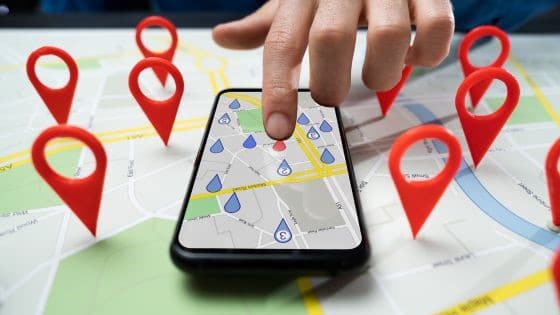Search engine optimization (SEO) is crucial for multi-location businesses of all sizes in all industries, but it’s important to understand the differences between local SEO and regular SEO, or organic SEO, in order to help prioritize strategies and get the best ROI.
Both types of SEO play essential roles in driving traffic and increasing visibility, but they differ in their primary purposes and target audiences.
For Multi-Location Businesses, specifically brick-and-mortar and service-area businesses, local SEO is particularly important.
Local SEO vs Organic SEO: Key Differences
To understand how local search engine optimization can benefit Multi-Location Brands, let’s first look at the differences between local SEO and organic SEO in a few key areas:
1. Target Audience and Reach
Local SEO:
- Focuses only on attracting customers within specific geographic areas.
- Essential for businesses with physical locations or that offer local services.
- Goal is to appear in local search results, like “plumber near me” or “best Italian restaurant in [City].”
Organic SEO:
- Aims to reach a broader audience, regardless of location.
- Ideal for businesses that mainly operate online or have a national or global customer base.
- Goal is to rank high up in organic results for relevant non-local keywords, or keywords that don’t have geo-modifiers (names of regions, cities, towns, or neighborhoods).
2. Search Engine Results Pages (SERPs)
Local SEO:
- Aims to get the business to appear in the local pack (map and list of top businesses on Google Maps related to the search query).
- Results appear above organic website results.
- Include details from Google Business Profile, like address, phone number, hours, and reviews.
Regular SEO:
- Focuses on getting the business’s website to rank well in organic results, which are listed below the local pack.
- Feature meta titles and descriptions that entice users to click through to the website.
3. Google Business Profile Optimization
Local SEO:
- Optimizing Google Business Profile (GBP) is critical for local SEO success.
- GBP serves as a comprehensive listing that includes essential business information, reviews, links, and photos.
- Well-optimized profiles improve visibility in Google Search and Google Maps results.
- Social proof, especially reviews, can make a big difference in a brand’s ranking in the local pack.
Organic SEO:
- GBP optimization is not central to organic search rankings (can indirectly benefit regular SEO by increasing brand visibility and driving website traffic).
- Factors like website content quality, backlinks, and technical SEO play a more significant role in organic search success.
4. Keywords and Content Strategy
Local SEO:
- Involves incorporating location-specific keywords into your Google Business Profile’s business description, services, and posts.
- Also involves creating website content that caters specifically to a local audience (like landing pages for different locations or locally targeted blog posts).
Regular SEO:
- Relies on broader keywords that can attract a wide audience.
- Content strategy focuses on creating high-quality, informative content that answers FAQs and provides solutions to common problems,
- Goal is to educate the target audience and establish authority in the industry.
5. Backlinks and Citations
Local SEO:
- Emphasizes obtaining backlinks from other local websites, directories, and organizations.
- Citations (online listings) on local directories and review sites are also important for local SEO success.
Organic SEO:
- Focuses on acquiring backlinks from authoritative websites within the industry, regardless of their geographic location.
Should Multi-Location Brands Focus on Local SEO or Regular SEO?
The decision to focus on local SEO or traditional SEO depends largely on the nature of the business and its goals. Multi-Location Businesses should consider the following factors when deciding which is right for them:
Local Businesses with Physical Locations or Service Areas
For businesses like restaurants, retail stores, service providers (e.g., plumbers, electricians), and medical practices, local SEO should be a top priority, as these types of businesses rely heavily on attracting customers from nearby.
Optimizing for local search, with its emphasis on Google Business Profile optimization, helps ensure that local businesses with physical locations or service areas appear in the local pack and on Google Maps, increasing foot traffic and local leads.
Online and E-commerce Businesses
Brands that operate primarily online (i.e., e-commerce businesses) or have a wide geographic reach should prioritize regular SEO over local SEO. These businesses benefit from targeting a broader audience and focusing on high-quality content and backlinks that can drive organic traffic from various locations.
Hybrid Approach
Many businesses can benefit from a hybrid approach that combines both local and traditional SEO strategies.
For example, a chocolatier with an online store should optimize for local search to attract nearby customers, while also focusing on organic SEO to reach a wider audience for its e-commerce site.
Budget and Resources
Local SEO can often be more cost-effective for smaller businesses with limited budgets, as it targets a narrower audience and can help them compete against larger enterprise organizations with bigger marketing budgets.
Regular SEO might require a more significant investment in content creation, technical optimization, and backlink acquisition, and it can be much harder to appear high up in organic website results than in the local pack.
Conclusion
Both regular SEO and local SEO can benefit Multi-Location Businesses, but the focus should align with the business’s specific needs and goals.
By understanding the differences between local SEO and organic SEO and strategically prioritizing efforts, Multi-Location Brands can get the most out of their resources when it comes to boosting their online visibility, attracting the right audience, and growing their business.




